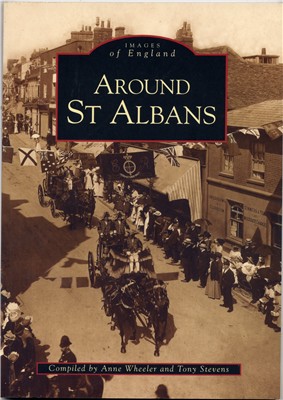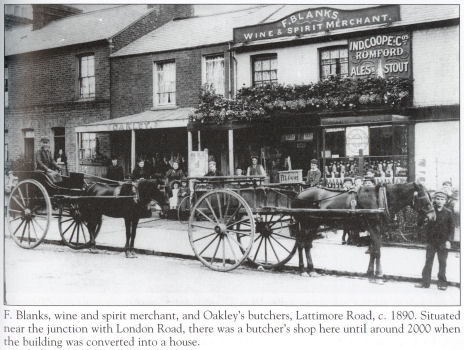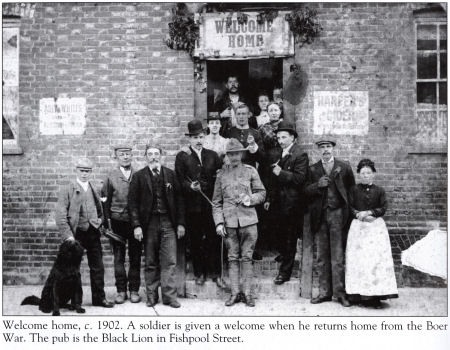 Around
Around
St Albans
Anne Wheeler & Tony Stevens
St Albans Museums & Tempus Publishing, 2001, ISBN 0 75242289 8
Paperback, 23.5*16.5 cm, 128 pages
The book consists of photographs, mainly from the first half of the 20th century, with three or four lines description of each.
CONTENT
City Centre; The Rural City; The Villages; Verulamium; Fleetville; Industry; Shops; Transport; Education; Sport & Leisure; Events; Religion; Alf Gentle; Arthur Melbourne-Cooper

INTRODUCTION
The photographs in this book have been selected from the collections of St Albans Museums. Built up over a period of more than 100 years, the service now cares for over 30,000 images on two sites - the Museum of St Albans in Hatfield Road and Verulamium Museum in St Michael's. The collection includes: photographs which have been donated by, or copied from, private individuals; work undertaken by the Museums Photographer, and material which has been specially commissioned. St Albans Museums are grateful to everyone who has donated or loaned photographs for copying.
As a result, the collections are a mixture of professional and amateur photographs and vary enormously in style and quality. Together the photographs help to build a picture of life in the St Albans district over the past 150 years and highlight many of the huge changes the area has witnessed within that time.
We have chosen to dedicate two chapters to two individual photographers who lived and worked in St Albans and whose work we believe to be of particular local significance.The first of these is Arthur Melbourne-Cooper (1874-1961), a professional photographer and important early film pioneer. Working in the late nineteenth and early twentieth centuries, he sold many of his photographs as postcards through his Alpha Trading Company. As a result most of his works tended to be fairly commercial in nature.
In contrast to this is Alf Gentle (1911-1992), an engineer by profession but an accomplished amateur photographer and founder member of the St Albans Photographic Society. He made his mark by photographing the ordinary aspects of 1960s and 1970s St Albans. Far from commercial in approach, Alfts photography shied away from the usual pretty pictures of the town, and instead focused on the less glamorous 'behind the scenes' aspects, including walls, drains and demolitions. Nearly 1,300 of his slides were donated to the museum by his family in 1996 and provide an excellent record. Slide shows using copies of Alf's pictures are given regularly to community groups.Photographs are an extremely valuable social history record and have an immediacy and accessibility which is hard to rival. They can provide an instant insight into the past, but with careful study they can reveal a much deeper understanding of history. It is often the little 'incidentals', such as the things that are pictured in the background, that turn out to be the most interesting. St Albans, like everywhere else, changes all the time and photography is one of the ways of capturing a little bit of the present for the future. After all, today's events are tomorrow's history.
Advances in technology and the development of digital imaging are already starting to help the museum expand the image library and make it more accessible. The pictures in this book include slides, lantern slides, negatives and stereo cards, as well as prints, and all have been digitally scanned on site by Museums Photographer, Jennifer Golding. This forms the start of the digitisation of the photographic collection which will bring many advantages for staff, public and the photographs themselves.Producing this book has been an enjoyable and worthwhile experience. The compilation process has greatly increased our knowledge of the collections and has enabled us to study the photographs in much closer detail than time usually allows, sometimes bringing new information to light.
Using previously unpublished photographs wherever possible, this book aims to illustrate some of those changes. We have also chosen images which have an interesting story to tell, a good balance of subject matter, and we have tried to get a good geographical spread across the district. We are very conscious of large gaps in the collection and are particularly keen to acquire material illustrating the multicultural nature of the district, and everyday life in the villages, suburbs and estates of the district.

St Albans Museums are interested in adding more digital pictures to their collection and if you are have suitable material they will be delighted to hear from you.
There is a web page for St Albans
Locating Books
At the time this page was last updated second hand copies could be ordered online
October 2010 Pictures added

